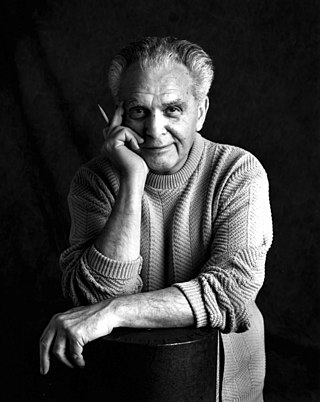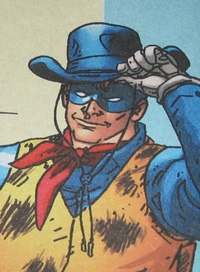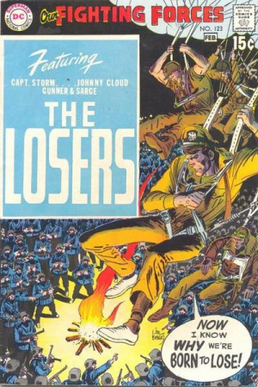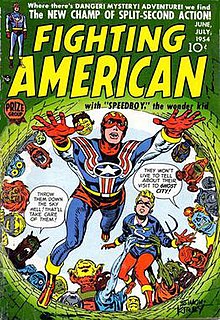
Captain America is a superhero created by Joe Simon and Jack Kirby who appears in American comic books published by Marvel Comics. The character first appeared in Captain America Comics #1, published on December 20, 1940 by Timely Comics, a corporate predecessor to Marvel. Captain America's civilian identity is Steve Rogers, a frail man enhanced to the peak of human physical perfection by an experimental "super-soldier serum" after joining the United States Army to aid the country's efforts in World War II. Equipped with an American flag-inspired costume and a virtually indestructible shield, Captain America and his sidekick Bucky Barnes clashed frequently with the villainous Red Skull and other members of the Axis powers. In the final days of the war, an accident left Captain America frozen in a state of suspended animation until he was revived in modern times. He resumes his exploits as a costumed hero and becomes leader of the superhero team the Avengers, but frequently struggles as a "man out of time" to adjust to the new era.

Jack Kirby was an American comic book artist, widely regarded as one of the medium's major innovators and one of its most prolific and influential creators. He grew up in New York City and learned to draw cartoon figures by tracing characters from comic strips and editorial cartoons. He entered the nascent comics industry in the 1930s, drawing various comics features under different pen names, including Jack Curtiss, before ultimately settling on Jack Kirby. In 1940, he and writer-editor Joe Simon created the highly successful superhero character Captain America for Timely Comics, predecessor of Marvel Comics. During the 1940s, Kirby regularly teamed with Simon, creating numerous characters for that company and for National Comics Publications, later to become DC Comics.

Joseph Henry Simon was an American comic book writer, artist, editor, and publisher. Simon created or co-created many important characters in the 1930s–1940s Golden Age of Comic Books and served as the first editor of Timely Comics, the company that would evolve into Marvel Comics.
Thor, the god of Norse mythology, has appeared as a character in various comics over the years, appearing in series from a range of publishers.

Robert Liefeld is an American comic book creator. A prominent writer and artist in the 1990s, he is known for co-creating the character Cable with writer Louise Simonson and the character Deadpool with writer Fabian Nicieza. In the early 1990s, Liefeld gained popularity due to his work on Marvel Comics' The New Mutants and later X-Force. In 1992, he and several other popular Marvel illustrators left the company to found Image Comics, which started a wave of comic books owned by their creators rather than by publishers. The first book published by Image Comics was Liefeld's Youngblood #1.

Nelson Alexander Ross is an American comic book writer and artist known primarily for his painted interiors, covers, and design work. He first became known with the 1994 miniseries Marvels, on which he collaborated with writer Kurt Busiek for Marvel Comics. He has since done a variety of projects for both Marvel and DC Comics, such as the 1996 miniseries Kingdom Come, which Ross co-wrote. Since then he has done covers and character designs for Busiek's series Astro City, and various projects for Dynamite Entertainment. His feature film work includes concept and narrative art for Spider-Man and Spider-Man 2, and DVD packaging art for the M. Night Shyamalan film Unbreakable. He has done covers for TV Guide, promotional artwork for the Academy Awards, posters and packaging design for video games, and his renditions of superheroes have been merchandised as action figures.

Youngblood is a superhero team that starred in their self-titled comic book, created by writer/artist Rob Liefeld. The team made its debut as a backup feature in RAMM #1 before the next month appearing in the one-shot Megaton Explosion #1 before later appearing in April 1992 in its own ongoing series as the flagship publication for Image Comics. Youngblood was originally published by Image Comics, and later by Awesome Entertainment. Upon Rob Liefeld's return to Image Comics, it was revived in 2008, 2012, and 2017. In 2019, Liefeld revealed that he has not owned the rights to Youngblood for several years.

The Two-Gun Kid is the name of two Western fictional characters appearing in American comic books published by Marvel Comics. The first, Clay Harder, was introduced in a 1948 comic from Marvel predecessor Timely Comics. The second, Matt Hawk a.k.a. Matthew J. Hawkins, was introduced in 1962 and has continued to appear into the 2010s. The latter Kid is better known, thanks primarily to his connection with, and later full integration into, the shared continuity of Marvel Comics known as the Marvel Universe, but the Clay Harder Kid enjoyed a 14-year span in comics.

Dark Circle Comics is an imprint of Archie Comics Publications, Inc. Under its previous name, Red Circle Comics, it published non-humor characters, particularly superheroes in the 1970s and 1980s.

The Shield is the name of several superheroes created by MLJ. Appearing months before Captain America, the Shield has the distinction of being the first superhero with a costume based upon United States patriotic iconography. The character appeared in Pep Comics from issue #1 to #65.

The Losers is the name of a war comic book feature published by DC Comics. The name was later given to a reimagined comic book series for DC's Vertigo imprint.

Boy Commandos is a fictional organization from DC Comics first appearing in Detective Comics #64 by Joe Simon and Jack Kirby. They are a combination of "kid gang" characters, an international cast of young boys fighting Nazis — or in their own parlance, "the Ratzies".

Vision (Aarkus) is a fictional character, a superhero appearing in American comic books published by Marvel Comics. Created by the writer Joe Simon and artist Jack Kirby, the character first appeared during the Golden Age of comic books in Marvel Mystery Comics #13, published by Marvel predecessor Timely Comics.

The Yellow Claw is a supervillain appearing in American comic books published by Marvel Comics. Created by writer Al Feldstein and artist Joe Maneely, the character first appeared in Yellow Claw #1, published by Atlas Comics, the 1950s predecessor of Marvel.

The Fighting Yank is the name of several superheroes, first appearing in Startling Comics #10.

Captain Victory is a comic book originally created, written and drawn by Jack Kirby. It was first published by American comic book publisher Pacific Comics in 1981. Kirby agreed to create a comic for the fledgling publisher because Pacific promised him full creative control, and ownership of the characters.

Crestwood Publications, also known as Feature Publications, was a magazine publisher that also published comic books from the 1940s through the 1960s. Its title Prize Comics contained what is considered the first ongoing horror comic-book feature, Dick Briefer's "Frankenstein". Crestwood is best known for its Prize Group imprint, published in the late 1940s to mid-1950s through packagers Joe Simon and Jack Kirby, who created such historically prominent titles as the horror comic Black Magic, the creator-owned superhero satire Fighting American, and the first romance comic title, Young Romance.
Awesome Comics or Awesome Entertainment was an American comic book studio formed in 1997 by Rob Liefeld following his expulsion from Image Comics, a company he co-founded five years prior. Awesome Comics was the successor of Extreme Studios and Maximum Press, Liefeld's imprints at Image, and was followed by his new company Arcade Comics upon its closure in 2000.

The Destroyer is the name of three fictional superheroes appearing in American comic books published by Marvel Comics. The original incarnation was created by writer Stan Lee and artist Jack Binder, and first appeared in Mystic Comics #6, being one of Lee's earliest creations during the Golden Age of comic books.
Francis Edward Herron was an American comic book writer and editor active in the 1940s–1960s, mainly for DC Comics. He is credited with co-creating Captain Marvel Jr. and the Red Skull, as well as such characters as Cave Carson, Nighthawk, and Mr. Scarlet and Pinky the Whiz Kid. Herron spent the bulk of his time in the comics industry writing for such characters as Green Arrow, Superman, and the Western character Tomahawk.

















